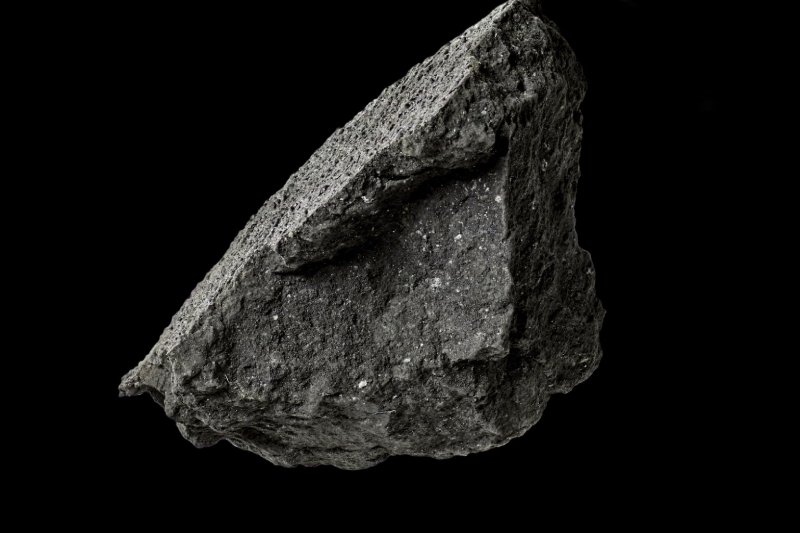The Winchcombe meteorite was impacted by water and frequently broke apart and reassembled during its space voyage, as shown by a thorough new nano-analysis, before landing in an English sheep farm in 2021.
On the study, researchers from numerous universities in the US, Australia, Europe, and the UK worked together. All of them combined to use a wide variety of state-of-the-art analytical methods to mineral grains found in Winchcombe meteorite fragments.
They have gained unmatched insight into the history of the Winchcombe meteorite as a result of their work, which was carried out on a scale usually reserved for examining samples returned to Earth by multibillion-dollar space missions.
Through their investigation, they have been able to go back in time to the meteorite’s early days as a dry rock bearing ice, and then follow its transformation into a ball of mud that was repeatedly ripped apart and reconstructed after the ice melted.
The Winchcombe meteorite belongs to a class of space rocks known as CM carbonaceous chondrites, which were created in the early stages of the solar system and are remarkably well-preserved. The minerals they transport have been modified by the water present on their parent asteroid.
Scientists can learn more about the processes that generated our solar system and the potential origins of Earth’s water by analyzing the minerals found in the Winchcombe meteorite.
The Winchcombe meteorite was found within hours of reaching the ground, in contrast to most meteorites that can remain undetected for months or even years after entering the Earth’s atmosphere. The general public, citizen scientists, and the amateur meteorite enthusiast community all acknowledged that rocks had fallen to Earth and assisted scientists in locating samples and facilitating their recovery.
Its rapid recovery helped keep it from being further damaged by exposure to Earth’s atmosphere, providing a unique opportunity for scientists to examine it at the atomic level and gain additional insight on CM chondrites.
Researchers explain how they investigated the intricate breccia of the Winchombe meteorite in an article that was published in the journal Meteoritics and Planetary Science.
A cataclastic matrix is a structure that holds fragments of other rocks together to generate breccias. The Winchcombe breccia contains eight different types of CM chondrite rocks, according to the team’s analysis, which was conducted using advanced techniques like transmission electron microscopy, electron backscatter diffraction, time of flight secondary ion mass spectrometry, and atom probe tomography.
The scientists discovered that water had, shockingly, changed each type of rock to a distinct extent both within and between the different types of rocks. The researchers discovered numerous instances of unmodified mineral grains adjacent to totally modified ones, even at the nanoscale. In contrast, the thickness of a human hair is approximately 75,000 nanometers.
The team hypothesizes that the Winchcombe asteroid was repeatedly smashed into pieces by impacts with other asteroids before being put back together. This would account for the disorganized form of the various types of rocks and their considerable diversity in aqueous alteration.
The very high percentage of carbonate minerals, such as aragonite, calcite, and dolomite, as well as minerals that have since replaced carbonates, among the samples the team investigated is another important finding of the analysis.
This implies that the carbon content of the Winchcombe meteorite was higher than previously believed, and it most likely accumulated a large amount of frozen CO2 before melting to form the carbonate crystals that the team saw. The team’s findings may provide an explanation for the sizable carbonate veins that NASA’s OSIRIS-REx spacecraft has seen on the surface of the asteroid Bennu.
Dr. Luke Daly from the University of Glasgow led the investigation and is the primary author of the paper. On February 28, 2021, a fireball was observed speeding across the skies over Gloucestershire. Dr. Daly headed the search crew that found the largest chunk of the Winchcombe meteorite.
According to Dr. Daly, “We were fascinated to uncover just how fragmented the breccia was within the Winchcombe sample we analyzed. If you imagine the Winchcombe meteorite as a jigsaw, what we saw in the analysis was as if each of the jigsaw pieces themselves had also been cut into smaller pieces, and then jumbled in a bag filled with fragments of seven other jigsaws.”
“However, what we’ve uncovered in trying to unjumble the jigsaws through our analyses is new insight into the very fine detail of how the rock was altered by water in space. It also gives us a clearer idea of how it must have been battered by impacts and reformed again and again over the course of its lifetime since it swirled together out of the solar nebula, billions of years ago.”
The study’s co-author, Dr. Leon Hicks of the University of Leicester, stated, “This level of analysis of the Winchcombe meteorite is virtually unprecedented for materials that weren’t directly returned to Earth from space missions, like moon rocks from the Apollo program or samples from the Ryugu asteroid collected by the Hayabusa 2 probe.”
“The speed which the fragments of Winchcombe were recovered left us with some pristine samples for analysis, from the centimeter scale all the way down to individual atoms within the rocks. Each grain is a tiny time capsule that, taken together, helps us build a remarkably clear view into the formation, re-formation, and alteration that occurred over the course of millions of years.” stated Dr. Martin Suttle, co-author of the paper and professor at the Open University.
“Research like this helps us understand the earliest part the formation of our solar system in a way that just isn’t possible without detailed analysis of materials that were right there in space as it happened. The Winchcombe meteorite is a remarkable piece of space history and I’m pleased to have been part of the team that has helped tell this new story.” said co-author Dr. Diane Johnson of Cranfield University.
